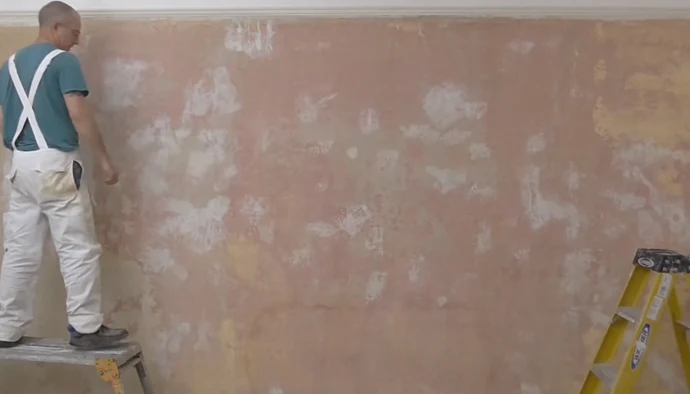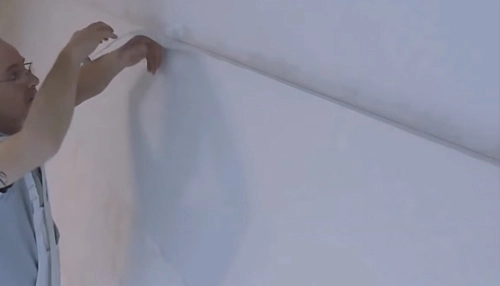Last Updated on June 18, 2022
Do you need to put up a mist coat before wallpapering? We’ll take a look at why this step is necessary, how to apply it, and whether it’s necessary to add water to an emulsion. If you’re going to wallpaper over a newly plastered wall, you can use a thin layer of emulsion to create a mist coat.
Putting up lining paper prior to wallpapering
If you plan to wallpaper a room, you should always put up lining paper. Liner paper has many advantages over wallpaper. It will make the wall smooth, and can disguise imperfections in the walls.
However, it is not necessary to use it for all wallpaper types. Some wallpapers can be applied directly to the wall without lining paper. However, if you want to use wallpaper on old plaster walls, you should use lining paper.
To install lining paper on a wall, you need to prepare it first. Start by measuring the space. Determine the width of the wall and the height. A standard wallpaper roll is between 530 and 560mm wide and 10m long.
Depending on the length of your room, you may need to buy a special roll. Make sure you measure the area thoroughly before you start. Use the measurement guide provided on the lining paper.
Depending on the type of wallpaper, you may need to put up lining paper before you start wallpapering. If the wallpaper is foil or thin, you may want to use a lining paper. Some manufacturers recommend lining walls before they apply wallpaper.
This is because different finishes may show through. Liner paper will prevent these colours from showing through. If you use lining paper, you can use a matte emulsion to obliterate the different finishes.
A typical interior wall contains a number of flaws. There are knock marks, hairline cracks, and dents. These imperfections will be covered with lining paper before you apply the wallpaper.
Using lining paper will not only increase the stability and durability of your wallpaper, but also make it easier to apply. As a bonus, it will save you money on plastering. Plus, it gives you a smooth and flawless finish the first time.
Why it’s necessary
Why lining paper needs a mist coating? Mist coats are watered down emulsion paints that act as a primer. The extra moisture helps the topcoat adhere to the substrate. Using a water-based primer before the topcoat is applied saves the mist coat and gives the finish an even, colourful finish.
The ratio of water to paint can vary depending on the manufacturer. The mist coat does not have to be the same colour as the final topcoat.
To apply a mist coat, start at the top of a wall and work your way down. If you’re using a roller, make sure the roller does not stick to one spot in the room.
The mist coat will need a couple of hours to completely dry and you should leave the room unattended for the overnight period. You can apply a second top coat after the first one has dried.
If you’re using a vinyl matt, you’ll need a diluted coat to be able to adhere to the surface. Some emulsion brands have specific primer instructions and if you don’t follow these, you’ll end up with a wall that is too smooth.
Vinyl matt is not recommended for use as a mist coat because it won’t let the substrate breathe as well.
When applying a mist coat to a newly plastered wall, you should make sure that you use a thin coat. If you’re applying a thick coat, it will drag the paint.
You’ll need to test the consistency of the paint on a small patch first. If it’s too thick, you may need to dilute it with water. In addition, don’t forget to apply a second coat if your wall has been plastered.
How to apply a mist coat to freshly plastered walls
When painting over freshly plastered walls, you must ensure that you use a mist coat to protect the new surface. This layer of paint should be applied in light layers over all surfaces. To prevent the mist coat from running and drying too quickly, use a damp cloth to wipe away any dust.
It is also recommended to use a dust sheet or masking tape to protect the edges of the surface. Because a mist coat is very thin, it will run more than a normal paint finish, so you’ll want to avoid unnecessary cleaning.
To apply a mist coat, you’ll want to prepare your freshly plastered wall before you begin painting. Prepare the area by laying down dust sheets. Then, use a water-based paint or a COAT paint diluted with 10% water.
This will help the paint adhere to the wall better. You may also want to use a primer. While a primer won’t make the paint look as smooth, it will help it adhere better to the surface.
After preparing freshly plastered walls for painting, you should wait for at least a week before applying a mist coat to seal the surface. Freshly plastered walls need time to dry because they absorb water and will lose the paint if painted over it too soon.
In order to ensure the longevity of the paint, misting the freshly plastered wall with a watered-down emulsion is the best way to do this.
Before applying a mist coat to freshly plasteres walls, you must allow the surface to dry completely. This depends on several factors, including time of year, heating and type of bare plaster.
If you’re painting an entire wall, it should be completely dry within three weeks. Once dry, it should match the colour of the colour in the Fig. 2 illustration, and it should be uniform throughout.
Adding water to emulsions as a mist coat can cause adhesion problems
When using emulsions as a misting coat, it is important to follow the manufacturers’ recommendations for dilution. Adding too much water to the mist coat can cause adhesion problems. However, adding water to a mist coat at the correct ratio is a good practice.
Many emulsions are formulated to be water-based, and the correct dilution will vary depending on the type of emulsion you are using.
Using a 1: 1 water/paint ratio for emulsions is recommended on freshly plastered walls. This is to prevent delamination. A mist coat improves adhesion but does not look like a finished product.
If necessary, you can overcoat the mist coat to suit your application. If you are concerned that your mist coat will not meet the manufacturers’ requirements, try adding more water.
An emulsion should be thick enough to cover the new plaster surface. You should use a white emulsion with a good coverage rate. A white emulsion does not need to be of high quality as it will act as a base colour for the top coat.
A typical mist coat ratio for emulsions is seven parts paint to three parts water. Thicker emulsions may require 50-50 water.
It is important to follow manufacturer instructions and recommendations. For instance, some brands of emulsions require a primer before they can be used as a mist coat.
It is important to adhere to these recommendations as deviating from them may lead to product failure. And if you decide to use vinyl matt as a mist coat, remember to thoroughly dry the plaster surface prior to applying a second coat.
Frequently Asked Questions (FAQs)
1. What is a mist coat?
A mist coat is a very thin coat of paint that is applied to a surface before the final coat of paint. This thin coat helps to even out the surface and provides a good base for the final coat of paint.
2. Do all lining papers require a mist coat?
No, not all lining papers require a mist coat.
3. How is a mist coat applied to lining paper?
A mist coat is usually applied with a roller or a paintbrush. It is a very thin layer of paint that is applied to the surface to help the paint adhere better.
4. What are the benefits of using a mist coat on lining paper?
A mist coat is a very thin layer of paint that is applied to the wall before the main coat of paint. This helps to seal the surface and provides a good surface for the paint to adhere to.
Conclusion
While a mist coat is not strictly necessary when lining paper, it can help to improve the final results. By applying a thin layer of paint before hanging the paper, you can help to create a smooth and even surface.
In addition, a mist coat can help to hide any imperfections in the underlying wall, further improving the finished look. Of course, applying a mist coat does add an extra step to the process, and it is possible to achieve good results without one. Ultimately, the decision of whether or not to use a mist coat is up to the individual.



